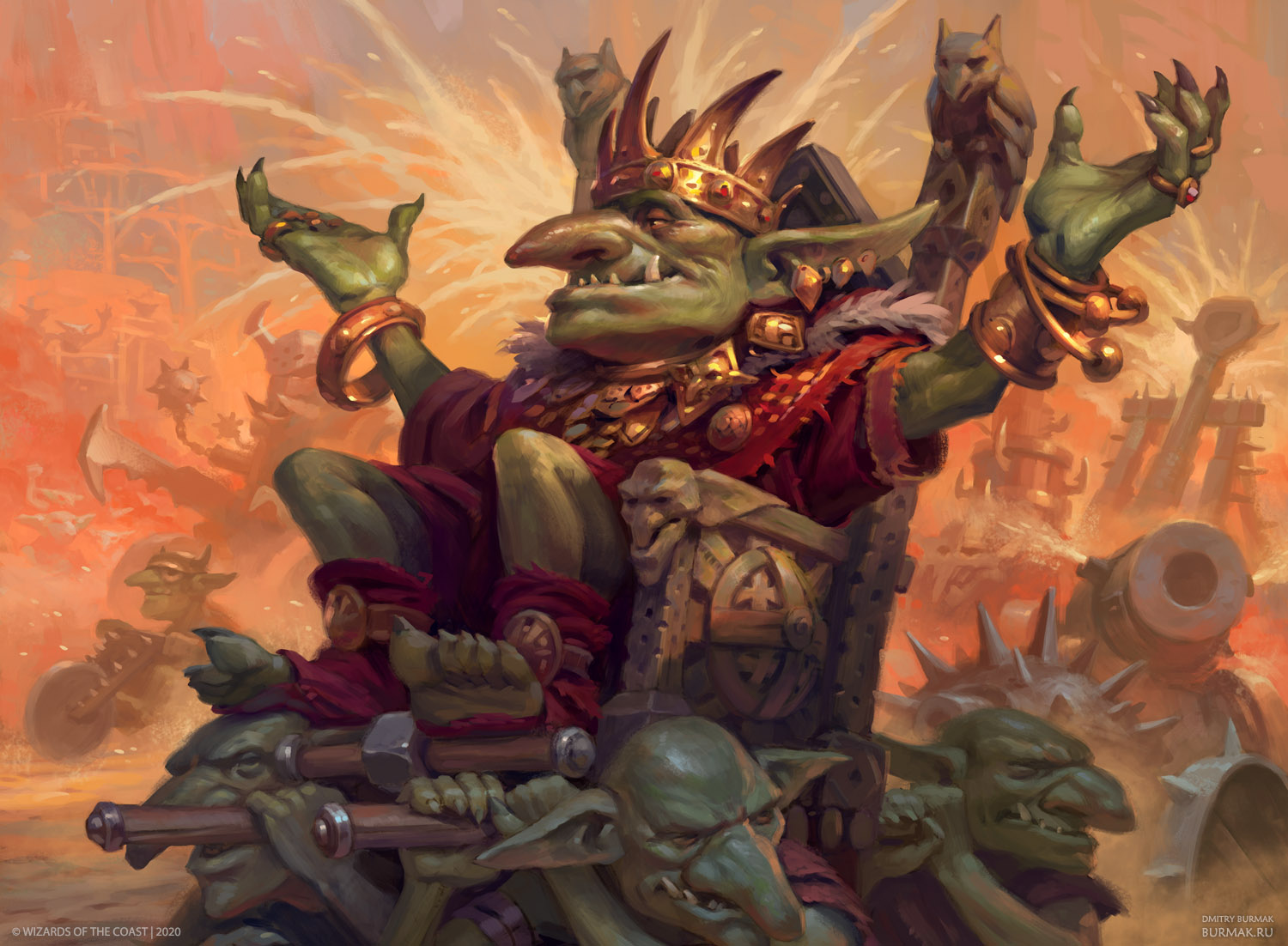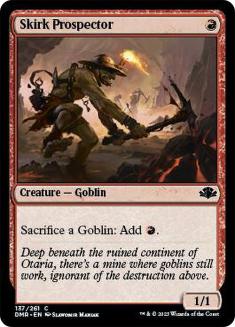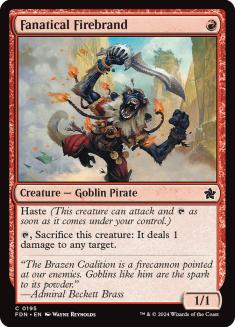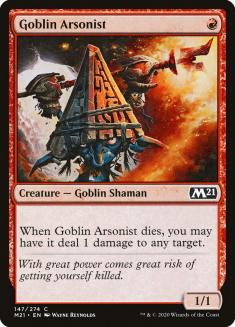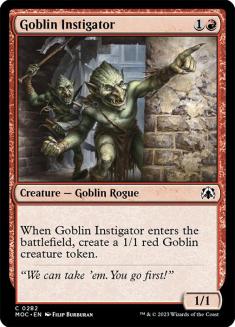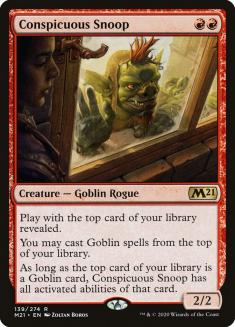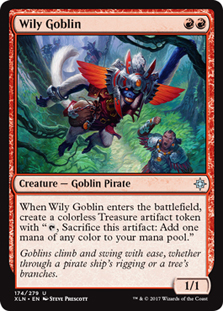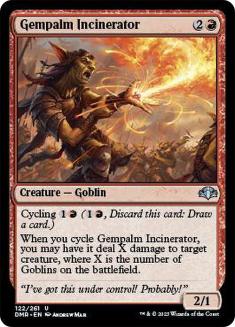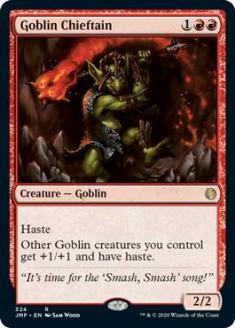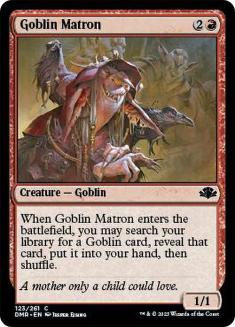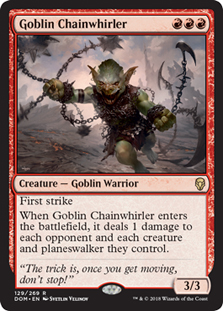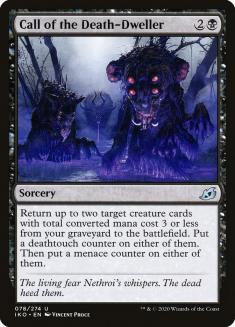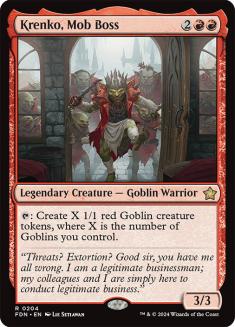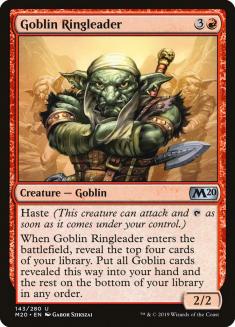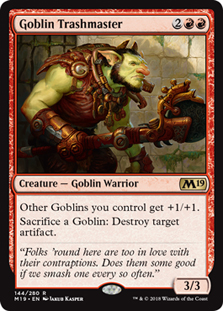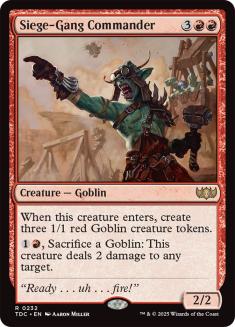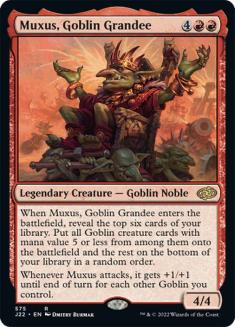Historic with Jumpstart is still very new, but Goblins has emerged as one of the early best decks, thanks to several new additions to the archetype.
For anyone who hasn’t dug deeply into Historic, it can be hard to track which cards have been introduced to the format, and this archetype draws from several releases outside of Standard products. When Historic was first announced, it seemed like a lower-powered format than Pioneer, and some players wondered if they’d eventually expand Historic into Pioneer, but the direction of the format since its creation has made it clear that Pioneer and Historic are two very different formats, and each will have a lot of cards that aren’t legal in the other. This Goblins deck, for example, is nowhere near being legal in Pioneer.
It’s hard to pin down exactly what the “core” of the Goblins archetype is, as there are several twists that focus on different aspects of what the tribe can do, so rather than opening by saying the deck is about a specific card, combination, or play pattern, I think I should just go through the most important tools available.
I find it easiest to approach evaluating options in a deck like this by mana cost, since you’re ultimately bound by curve considerations no matter what, so cards with the same cost are always competing against each other somewhat more directly than they compete against cards with other costs.
One Mana
Skirk Prospector is the best one-mana Goblin by a pretty wide margin. This card’s value shifts a lot depending on which other cards are legal and what you’re trying to do, but Historic offers a wide range of tools to make the most of Skirk Prospector, which means easy access to 1/1 Goblins from Goblin Instigator; Goblin Matron; Wily Goblin; and Krenko, Mob Boss as well as great mana sinks thanks to Conspicuous Snoop; Goblin Matron; Goblin Ringleader; and Muxus, Goblin Grandee; with simply getting to six mana to cast Muxus as the real highlight here.
While there are eleven other legal one-mana Goblins in Historic, there’s a good case to be made for not playing any of them. The most relevant considerations are Goblin Arsonist and Fanatical Firebrand. Both of these options offer the deck a little extra possible removal, and both are at their best in a Rakdos variant of the deck that splashes black for Call of the Death-Dweller. In that context I prefer Fanatical Firebrand so that you don’t need to jump through any additional hoops to get your removal when you want it.
Two Mana
There’s probably some way to build Goblins to focus on elements where Goblin Instigator could potentially not make the cut, but given that the archetype has multiple lords available in addition to multiple cards that count Goblins on the battlefield and multiple ways to sacrifice creatures for some kind of meaningful output, it’s hard to turn down two Goblins for two mana.
This deck doesn’t have the combo kill available in Modern, so here the Snoop is just a two-mana Experimental Frenzy that can’t play lands but doesn’t restrict your ability to play cards from your hand, attached to a two-mana 2/2 that can occasionally pick up Krenko, Mob Boss’s ability. Another card that it’s hard for me to believe I wouldn’t want four copies of, though I’ve seen lists with fewer.
Noted Wily Goblin enthusiast and Play Design member Donald Smith must be loving this chance to see Wily Goblin shine. This is basically an additional Goblin Instigator that doesn’t require Skirk Prospector to help cast Muxus early. It’s possible to build the deck in a way that doesn’t lean as heavily on Muxus, in which case I could understand skipping Wily Goblin, but I believe Muxus is worth playing toward and that Wily Goblin is worth using to facilitate that.
Technically this is a Goblin that has a converted mana cost of three, but realistically, if you put this card in your deck, you’re planning to spend two mana to use it. Sometimes this card isn’t a two-mana Murder, but honestly, it usually is. While there are a lot of decks in Historic that don’t really rely on creatures, I can’t imagine playing Goblins without four Gempalm Incinerators in my 75, and I think the card’s too strong not to just start with four of them.
Fringe Options
Goblin Cratermaker and Ember Hauler are very similar cards that are both legal and I’ve seen both played. Personally, I think the other options are better, but these are reasonable sideboard considerations if you want additional removal. I’ve also seen Goblin Shortcutter used, but without Goblin Piledriver in the format, I don’t really see the appeal. I think this decks plan against a single large blocker is either to kill it with Gempalm Incinerator or go around it. I personally don’t like including any other two-mana Goblins.
Three Mana
While it’s debatable, I think this is the premier three-drop in the archetype. Part of me wants to imagine a world where it’s Goblin Warchief, and you can use Skirk Prospector to convert Goblin Instigator into Rite of Flame and then…I don’t know, go off with Conspicuous Snoop or Goblin Ringleader (?), but all of that stuff is somewhere between winning more and a fragile pipe dream that just results in not winning at all.
The reality is that Goblin Chieftain wins the exact right amount. Pumping the Goblins you already have means it has a much more dramatic immediate impact than Goblin Warchief, and combining the increased size with haste makes it very easy to kill an opponent if you untap with Goblin Chieftain by casting Krenko, Mob Boss or Muxus, Goblin Grandee. Again, I’ve seen people play fewer than four, but I think that’s a big mistake.
Ignoring Gempalm Incinerator, I think Goblin Chieftain is the only sure thing at three mana, and your other choices distinguish various approaches to the archetype.
Goblin Matron inarguably indicates a lower priority on aggression in favor of either a toolbox or a dedicated plan to rely on a certain card or combination of cards. The biggest reason to play Goblin Matron is to reliably have access to Muxus. If you have’t drawn Muxus, it finds it; if you’ve drawn Muxus but not enough lands, that means you’ve drawn a lot of Goblins, so maybe you want to find Skirk Prospector.
Gempalm Incinerator will always be another common go-to, and the ability to double as a removal spell is one of the bigger draws to Goblin Matron. You can also include bullets like Goblin Ringleader to reload if you’ve been playing an attrition game and don’t have the mana for Muxus, or Goblin Trashmaster as artifact removal that furthers your gameplan.
Despite its virtues, I have concerns that it might actually be too slow for the format, and that, while it lets you consistently do a certain powerful thing, the power level in the deck is actually high enough that without sinking three mana into a 1/1, you can actually do something more powerful — you won’t choose which powerful thing you’re doing, but the deck will provide something powerful.
This is mostly used as a sideboard card in Mono-Red Goblins, but it’s the main joke in Rakdos Goblins, in that Call of the Death-Dweller allows you to create a Plague Wind that leaves you with a 3/3 creature that wins every combat. A great but not unbeatable card in the mirror that shines in a few other matches, I think there’s a good chance this should be a consideration for the maindeck even in Mono-Red.
Fringe Options
I mentioned that Goblin Warchief is definitely worse than Goblin Chieftain, but that Goblin Chieftain is great, so I think it’s reasonable to play a Goblin Warchief as a fifth haste lord, and the cost reduction can definitely matter. You can even play more than one, but I don’t think you want a lot of them.
I’ve only seen Legion Warboss in sideboards, but it’s the one three-mana Goblin I’d be excited to cast on Turn 2 with a Skirk Prospector, and if you’re leaning into the idea that you just want to fill your deck with strong cards to try to do something great every game, I think it’s a very reasonable card to consider. Another option that I haven’t seen explored but that’s very strong with Goblin Chieftain is Krenko, Tin Street Kingpin. I think this Krenko is pretty clearly outshined by Krenko, Mob Boss, but it’s legal to play with both.
This is the one non-Goblin and one nonred card I’m interested in considering in this archetype. Between Phyrexian Tower and Skirk Prospector, it’s easy to get your own Goblin Chainwhirler in the graveyard, and bringing it back with Call of the Death-Dweller is usually a game-winning play against most creature decks. You can also use Fanatical Firebrand as a backup combo, and your deck is full of fine creatures to return for value.
That said, adding a color is always a cost, and adding a non-Goblin to a deck with Conspicuous Snoop and Muxus, Goblin Grandee comes at a very high cost. I think this splash improves your creature matchups but hurts against noncreature decks. I honestly think it’s even potentially reasonable to splash black only for sideboard cards and that Call of the Death-Dweller can be one such sideboard card.
Four Mana
I’ve seen some builds that skip on Krenko entirely, and I think that’s a mistake. Krenko wins the game easily with Goblin Chieftain and almost always demands an answer. I’m not sure how many copies should be played, but I like at least one or two in any build of the deck.
This one’s tricky. It’s slow, but powerful, and at its best in attrition games. I think I like playing one if you’re playing Goblin Matron, but more than that feels like you’re taking the slower option that’s more geared toward grinding in multiple spots, and I think that can make your deck too slow.
If you’re not playing Goblin Matron, you could play this instead as a way of accomplishing a similar goal, and I think your Ringleaders will be better without Matron in your deck, since once you’ve added a bunch of Goblins to your hand, you don’t really want to spend three mana to add another Goblin to your hand; you’d rather hit high-impact payoffs. Given the Goblin density of the deck, Ringleader honestly sounds better than Matron to me, but I also think it’s reasonable to play Goblin Ringleader as a sideboard card against removal.
If your opponent’s playing multiple artifacts, this card is incredible, and if they aren’t, it’s still a lord, but nowhere near as strong as Goblin Chieftain. I think this is probably a sideboard card unless a deck with several artifacts becomes prominent.
Five Mana
Siege-Gang Commander is the only five mana consideration, and as much as I love it, it’s probably not worth it, though I’d be tempted if I were playing Goblin Matron.
Six Mana
For some, this is the main draw to the deck, and for good reason. When you resolve this, you almost always have outs to win the game on the spot, and the average hits are well worth six mana, even if that mana came from sacrificing Goblins. I’ve seen some builds with only a single Muxus, which I suspect isn’t right, but I think it’s justifiable if you want to focus more on your early-game and avoid playing Wily Goblin. Still, I think it’s better to just play around three Muxuses and pick up some easy wins.
Lands
When we’re talking about a mono-red deck, the manabase should be pretty simple, and it is, but there are a few options. Outside of basic Mountain, the considerations are Phyrexian Tower, Castle Embereth, and potentially Forgotten Cave (though I’m not a fan of that one). I think you want three or four Castle Embereths if you’re mono-red, and I also think I generally like the first Phyrexian Tower, but I could see not playing it because of concerns about Goblin Chainwhirler. If you’re not playing Goblin Chainwhirler and you have a particularly Muxus-focused build, I could see playing a second Phyrexian Tower, but I think the third is overkill.
Sideboard
Adding non-Goblins to your deck doesn’t stop making all your Goblin synergies worse after sideboarding, so you still want as much of your sideboard to consist of Goblins as possible.
- Legion Warboss is a great option. It’s frequently good on the play and almost always good against opponents with few creatures.
- Goblin Chainwhirler is another fairly easy choice if you’re not playing it in your maindeck.
- Goblin Ruinblaster should be an easy inclusion as long as Field of the Dead is legal.
- Goblin Trashmaster and Goblin Cratermaker are good options for answering artifacts, and Cratermaker can also come in when you want more creature removal.
- If you really want more removal, you could include Volley Veteran, but I wouldn’t.
- Outside of Goblins, Soul-Guide Lantern is a reasonable inclusion that sets the level of impact you’re looking for in a sideboard consideration.
- If you’re splashing black, I’d consider Call of the Death-Dweller and I might also play a discard spell, likely Agonizing Remorse, but Drill Bit wouldn’t be out of the question. While I haven’t seen it, I think Damping Sphere is worth keeping in mind if decks like Kethis Combo and Temur Song become more common.
My Take
Creatures (35)
- 4 Gempalm Incinerator
- 4 Skirk Prospector
- 4 Goblin Chieftain
- 2 Krenko, Mob Boss
- 4 Wily Goblin
- 2 Fanatical Firebrand
- 4 Goblin Chainwhirler
- 4 Goblin Instigator
- 4 Conspicuous Snoop
- 3 Muxus, Goblin Grandee
Lands (12)
Spells (13)

I think lands to include a black splash don’t hurt the deck much, and I think Chainwhirler plus Call offers an edge in the mirror as well as all the other creature decks, and I don’t think it turns many matchups against you, so I think it’s worthwhile. I still want to keep the core of the deck, and still want to be able to cast a fast Muxus often, but I don’t want to slow my deck down with Goblin Matrons. Given that I’m not really interested in Goblin Matron to begin with, I don’t think I’m giving up much to play Goblin Chainwhirler.
If I were to play Mono-Red Goblins instead, I’d build it like this:
Creatures (36)
- 3 Goblin Warchief
- 4 Gempalm Incinerator
- 3 Goblin Ringleader
- 4 Skirk Prospector
- 4 Goblin Chieftain
- 3 Krenko, Mob Boss
- 4 Wily Goblin
- 4 Goblin Instigator
- 4 Conspicuous Snoop
- 3 Muxus, Goblin Grandee
Lands (4)
Spells (20)
- 20 Mountain

This build is leaning heavily on trying to give Krenko haste, and also maximizing the synergy between Goblin Warchief and Goblin Ringleader to fill my hands with Goblins that I can unload more easily.
Minimizing my one-mana Goblins helps improve my Ringleaders and Muxus’s, as I’m hitting fewer low-impact Goblins.
This build is a little unusual, but I’m basically trusting my read that Goblin Ringleader is a stronger card than Goblin Matron, which I feel reasonably confident in, since these aren’t exactly new cards.
If I weren’t going to play Warchiefs and Ringleaders, I’d probably try maindeck Legion Warbosses instead, but I think that might lead to heavily polarizing my matchups.
Goblins is an exciting deck at the moment. It clearly has the tools to compete, but I don’t think the basics have fully been solved, and even once that happens, I think there are definitely tradeoffs where cards have strengths against different decks. So despite this deck’s heavily linear nature, it will definitely continue to evolve with the format.

